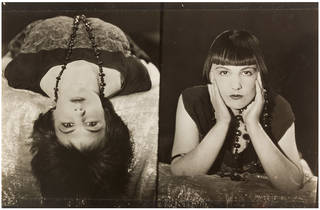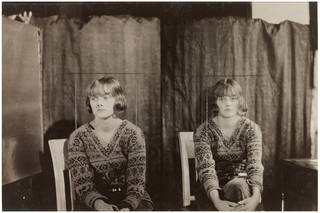In the early 1920s, Curtis Moffat (1887 – 1949) collaborated with photographer Man Ray in Paris, making portraits and abstract 'photograms', or 'Rayographs', an innovative camera-less technique. He also created pioneering colour still lifes, and glamorous society portraits.

Striking portraits
In his London portrait studio, Moffat created images of elegant simplicity, using striking poses and strong directional lighting. He employed a broad repertoire of poses, props, clothing and accessories to evoke the character of the sitter and to create a mood of elegance, opulence and allure. He mounted his enlarged portraits on layers of textured and brightly coloured papers, setting them slightly off-centre in the frame to create a dynamic and desirable finished object.
Moffat often printed two separate exposures together on one sheet of photographic paper, probably to economise on materials. These multiple images and contact sheets reveal his process in experimenting with different poses to reach the final image. Red and black pencil markings on some of the contact sheets show how he intended to crop or enlarge portions of the image.


Snapshots
Moffat's photographic activity also reached beyond the confines of his studio. The Moffat archive at the V&A includes a large number of contact prints (made by placing the negative directly on to a piece of photographic paper to obtain a small, quick reference image) that reveal his eye for finding informal still life compositions in daily life. Often shot from unusual angles or employing dramatic cropping, his snapshots record the textures of stone, water and plants, as well as modern motifs. Moffat may have used these contact prints at a later date to work up ideas for advertising, commercial or personal work.


Photograms
From 1923, in collaboration with the American Surrealist artist Man Ray in Paris, Moffat began experimenting with photogram techniques (images made without a camera by placing objects directly onto the surface of a light-sensitive material and then exposing it to light). He titled his works Abstract Compositions and exhibited them in the showrooms of his London interior design emporium, Curtis Moffat Ltd., at 4 Fitzroy Square in London. In this setting he saw them as an element within a wider decorative scheme, yet he also showed them as artworks in their own right, describing them as 'painting with light'. Besides the photogram, Moffat's Abstract Compositions also employed other camera-less techniques. In one image, an insect's body – grasshopper, locus or cricket – is used in place of a photographic negative.

In another, Moffat appears to have painted directly on to the paper, perhaps with photographic chemicals.

Colour photography
During the 1930s, Moffat pioneered a complex colour print process called 'tri-carbro' or 'three colour carbro process'. This process required three separately exposed black and white glass plate negatives, with each exposure made through a different filter of red, green and blue. The negatives were printed onto thin sheets of gelatine stained in these colours. Each sheet was then mounted by overlaying one on top of the other.

Moffat's colour photography was used for both commercial work and artistic still lifes which were critically appraised.
Find out more about Curtis Moffat.


